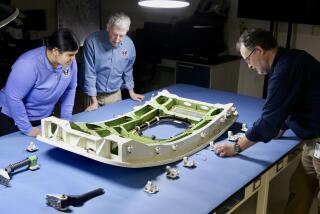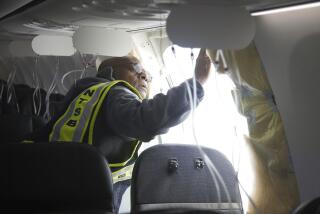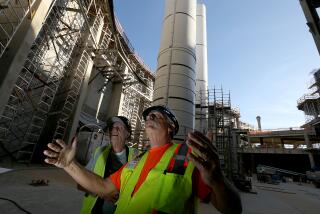NASA Takes Some of Burbank Firm’s Bolts Off Shuttle
- Share via
The National Aeronautics and Space Administration replaced more than 350 potentially substandard bolts in the space shuttle Discovery scheduled for launch later this month but decided to leave another 430 suspected bolts within the shuttle’s solid rocket boosters, NASA officials said Friday.
The bolts still inside the boosters are not used in critical applications, NASA officials said, and do not pose a safety threat to the five Discovery crew members.
“If there were to be a bolt-related failure on Discovery, it would have escaped the very detailed scrutiny of the very best engineers in this country,” said Wiley Bunn, director of quality assurance at NASA’s Marshall Space Flight Center in Huntsville, Ala. “You have a better chance of losing a leg on your way home tonight than a bolt failing on that vehicle and causing a problem.”
According to NASA, the suspect bolts were manufactured by Lawrence Engineering & Supply Inc. of Burbank. As part of an internal safety inspection sometime around March, NASA was alerted by one of its subcontractors that some Lawrence Engineering bolts might not meet required safety standards. The agency then started an investigation into Lawrence’s bolts.
“We did some testing and sure enough we found ones that were not as strong as they should have been,” said Bunn.
Lester Lawrence, president of Lawrence Engineering, was unavailable for comment. The company’s attorney, Ross Arbiter, said the firm was unaware that its bolts were removed. “We have never been advised by the government that any of our products have caused any problems,” said Arbiter.
Lawrence Engineering is currently the subject of an investigation by federal authorities for allegedly falsifying documents that said its bolts met government safety standards.
The company is being investigated by the Defense Criminal Investigative Service, or DCIS, which is a division of the Defense Department.
Lawrence’s bolts have been purchased for everything from the space shuttle to Lockheed’s Trident II nuclear ballistic missile, according to papers filed in U.S District Court in Los Angeles as part of the DCIS investigation.
Purchasing Practices Cited
The Times has obtained a NASA alert to contractors that said some Lawrence Engineering certification materials “had been supplied without some of the tests being performed.” Employees at Lawrence Engineering have told federal investigators that they were told to “fill in the blanks” on certification forms even though tests allegedly had not been conducted, according to court papers.
NASA said it was able to remove 357 of Lawrence Engineering bolts because some sections containing the bolts were still under construction in March by United Space Boosters Inc., a Huntsville, Ala.-based division of United Technologies.
NASA said the remaining suspect bolts are not used to hold together the booster rockets. Bunn said they are in non-critical applications such as the box that contains a transmitter that sends back data on the shuttle to NASA control.
“We would not have left any of the bolts--no matter how many of them there were--in a critical application,” said Bunn. He said there are plenty of backup bolts in all of the remaining applications should any of the suspect bolts fail.
NASA and other government agencies often are required to buy parts from the lowest bidder. It is a system that some critics have derided.
“The parts being bought by the government can come from any source. And there’s a good chance it’s a cheap source, not a qualified one, “ said H. LeRoy Oliver, a Ventura parts distributor and a consultant to the DCIS federal investigation of parts makers. “The NASA story is really a sad one. They had to tear the shuttle apart because of their buying practices.”
More to Read
Sign up for Essential California
The most important California stories and recommendations in your inbox every morning.
You may occasionally receive promotional content from the Los Angeles Times.













